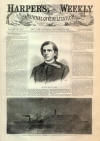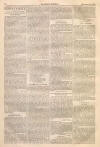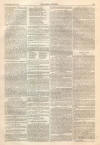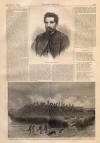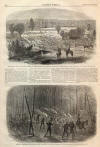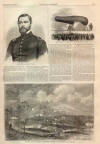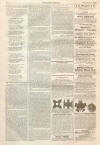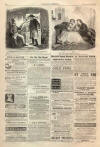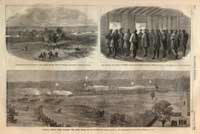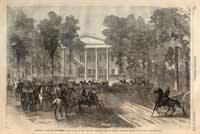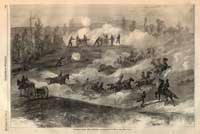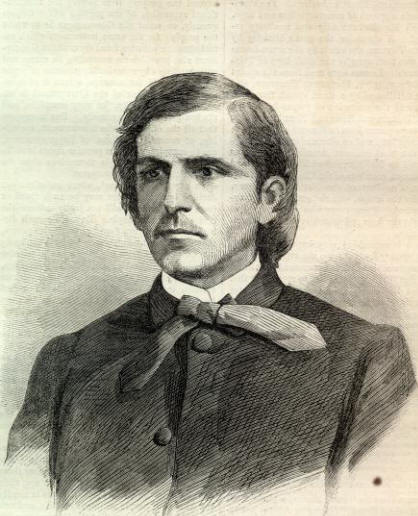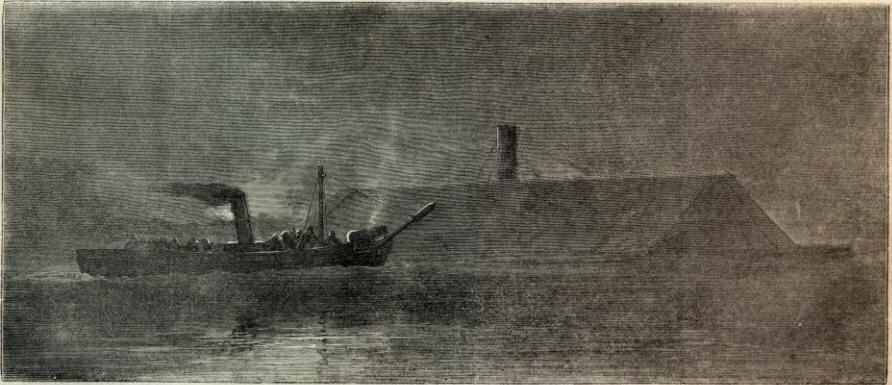|
This Site:
Civil War
Civil War Overview
Civil War 1861
Civil War 1862
Civil War 1863
Civil War 1864
Civil War 1865
Civil War Battles
Confederate Generals
Union Generals
Confederate History
Robert E. Lee
Civil War Medicine
Lincoln Assassination
Slavery
Site Search
Civil War Links
Civil War Art
Mexican War
Republic of Texas
Indians
Winslow Homer
Thomas Nast
Mathew Brady
Western Art
Civil War Gifts
Robert E. Lee Portrait
|
SINGLE COPIES
TEN CENTS.
$ 4.00 PER YEAR IN ADVANCE.
Entered
according to Act of Congress, in the Year 1864, by Harper & Brothers, in
the Clerk's Office of the District Court for the Southern District of New York.
THE DESTRUCTION OF THE
" ALBEMARLE."
WE
illustrate on this page one of the most exciting
incidents of naval warfare, and give a portrait of the chief actor concerned,
Lieutenant WILLIAM
B. CUSHING.
The rebel ram
Albemarle was one of the most formidable vessels which the Confederate
navy ever floated. It played a conspicuous part in the capture of Plymouth last
spring, and on that occasion sank the
South
field. She attacked the
Miami also ; and a shot from the latter, striking the iron walls of the
ram, rebounded and killed Captain
FLUSSER of the
Miami, who was an intimate friend of CUSHING
It is said that for this reason Lieutenant CUSHING
vowed vengeance against the
Albemarle. This ram was the same which was engaged in the memorable
conflict with the
Sassacus, and two other heavily-armed double-enders on the 5th of May
last —an event which was illustrated in the
Weekly for June 4. The utmost, however, which these three vessels by
their combined efforts were able to accomplish amounted to but a slight injury
to the rebel iron-clad, though sufficient to compel its retirement. It has ever
since been a source of considerable apprehension, and has made it necessary for
Admiral LEE
to greatly increase his naval force in the Sound. As early as last June
Lieutenant
CUSHING, then commanding the
Monticello, submitted to the Admiral a plan for the destruction of the
Albemarle. The plan was approved, and the Lieutenant withdrawn from the
Monticello to perform this special service. Since that date Admiral
LEE has been succeeded by
Admiral PORTER, who has signalized his
assumption of command by the destruction of the ALBEMARLE.
After the conception of his plan Lieutenant CUSHING
came to New York, and, in conjunction with Admiral
GREGORY, Captain
BOGGS, and Chief Engineer W. W. Wood, applied to one of the new
steam-pickets a torpedo arrangement and returned to the Sound. The
torpedo
arrangement was invented by Mr. Wood, and was illustrated in the
Weekly of October 1. The
Albemarle had been lying at Plymouth for some weeks previous to its
destruction. A mile below the town on the wreck of the
Southfield a rebel picket was stationed. On the night of October 27
CUSHING, with a company of thirteen men, proceeded up the Roanoke River
toward Plymouth. The distance from the mouth of the river to the ram was eight
miles. The picket above-mentioned was passed without alarm, and the
Albemarle was discovered lying fast to the wharf "with logs around her
about thirty feet from her side." As the party approached the rebels opened fire
from the shore, which was returned by the steam-launch. The approach was made
in the form of a circle and with bows on, and when the logs were struck they
were driven in some feet, the bows of the launch resting on them. "The
torpedo-boom was then lowered," says Lieutenant CUSHING, " and by a vigorous
pull I succeeded in
diving the
torpedo under the overhang, and exploding it at the same time that
the
Albemarle's gun was fired. A shot seemed to go crashing
through my boat, and a dense mass of water rushed in from the torpedo,
filling the launch and completely disabling her. The enemy then continued his
fire at fifteen feet range and demanded our surrender,
which I twice refused, ordering the men to save themselves and removing
my overcoat and shoes. Springing into the river I swam, with others, into the
middle of the stream, the rebels failing to hit us."
CUSHING'S
escape was so precipitate that he was not able to report the destruction of the
ram from
his own observation, but formed his judgment from a conversation which he heard
while concealed in the marshes close to the enemy's
fort, and from the report of a negro whom he sent into the town for information.
He had become exhausted in swimming, and had taken shelter in the immediate
vicinity of the enemy. He was picked up by the
Valley City on the night of the 30th, having made his way to that vessel
in a skiff captured from an enemy's picket.
Lieutenant
CUSHING is a citizen of New York.
From the Richmond papers we learn that the
Albemarle was destroyed, and that none of CUSHING's
party were killed, only one of them, indeed, having been wounded. No lives were
lost on board the
Albemarle. The destruction of this vessel has given us possession of
Plymouth.
GUNS CAPTURED BY
SHERIDAN.
WE engraved last week an
illustration representing
the arrival at the War Department of the
battleflags captured from the rebels
by General SHERIDAN.
A few days after this event, on October 29, General TORBERT
arrived in
Washington with the pieces of artillery, nearly thirty in number,
which were taken from the rebels in the battle of Cedar Creek. We give on page
714 an illustration of the reception of these guns at the War Department. These
did not, of course, include those of our guns which had been captured by the
enemy and were afterward retaken. The capture of guns from the rebel army of
Virginia can only be accomplished after a severe struggle. The rebels hold on to
their guns till the last, and only yield them because they must. This fact,
taken in consideration with the
large number of guns which
SHERIDAN
has captured in his
recent campaign, indicates the severity of the fighting which has been done this
fall in the
Shenandoah
Valley. Our superiority in cavalry
has doubtless diminished the difficulty which has always attended the capture
of artillery on our part.
BATTERY GOING INTO POSITION.
WE engrave on page 745 an
illustration which one of our artists in the West sends us, representing
in a spirited manner the appearance of a battery
of flying artillery going into position. The artillery of an army is one of its
most powerful auxiliaries. It multiplies many times the effect of a single
musket, and is equal to the addition to an army of several thousand men. As the
cavalry represents
the velocity and dash of onset, so the artillery represents the weight and volume
of attack. It is of especial value in checking an advance of the enemy either in
front or on the flank; and it is for this reason that an assailing column aims
first at the adversary's guns, because these having been captured the lines of
infantry are easily broken up and routed.
DESTRUCTION OF THE REBEL RAM "ALBEMARLE" AT PLYMOUTH, NORTH CAROLINA OCTOBER 27,
1864
We acquired this leaf for the purpose of digitally
preserving it for your research and enjoyment. If you would like
to acquire the original 140+ year old Harper's Weekly leaf we used to
create this page, it is available for a price of $175. Your
purchase allows us to continue to archive more original material. For
more information, contact
paul@sonofthesouth.net
|
